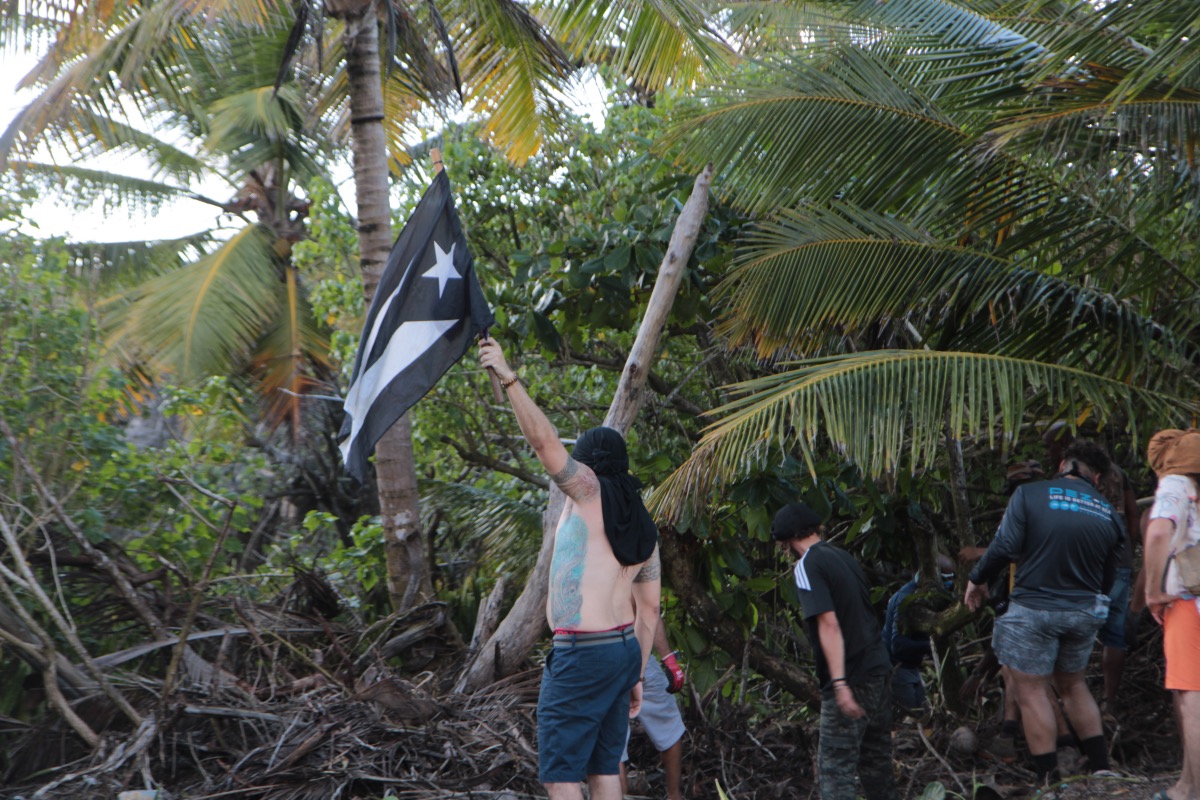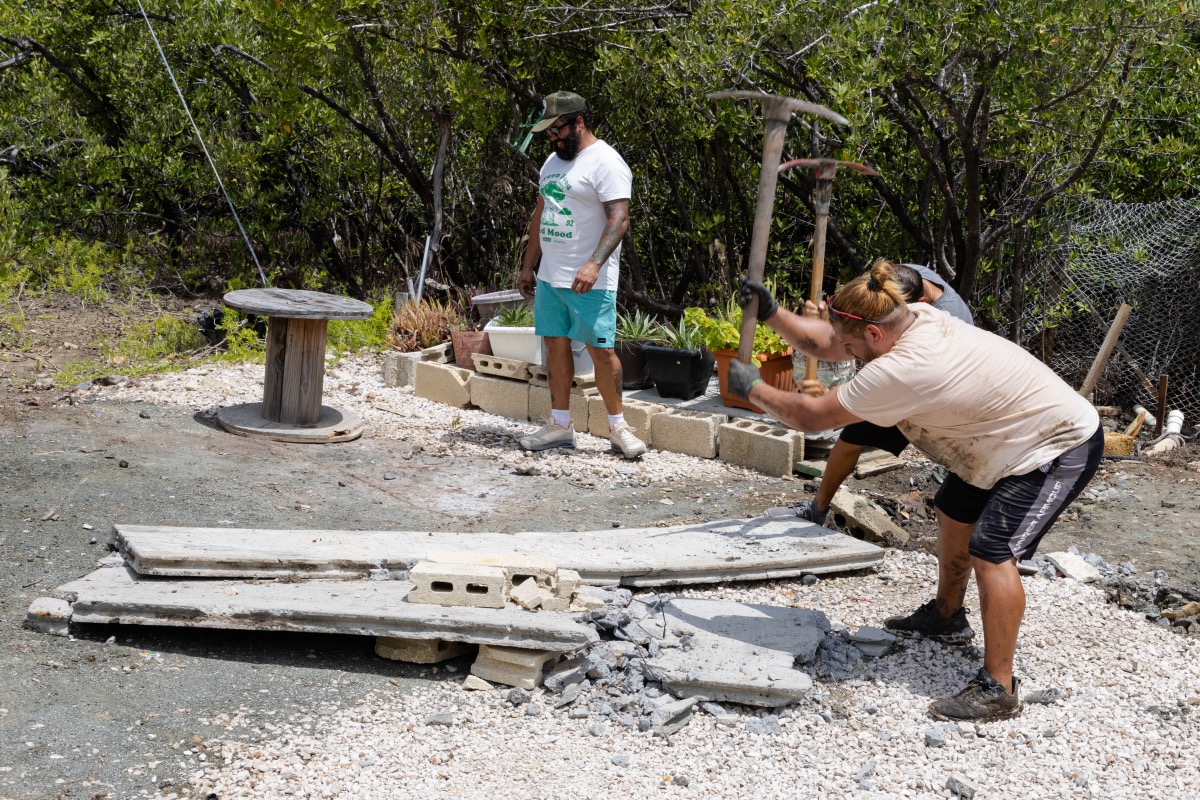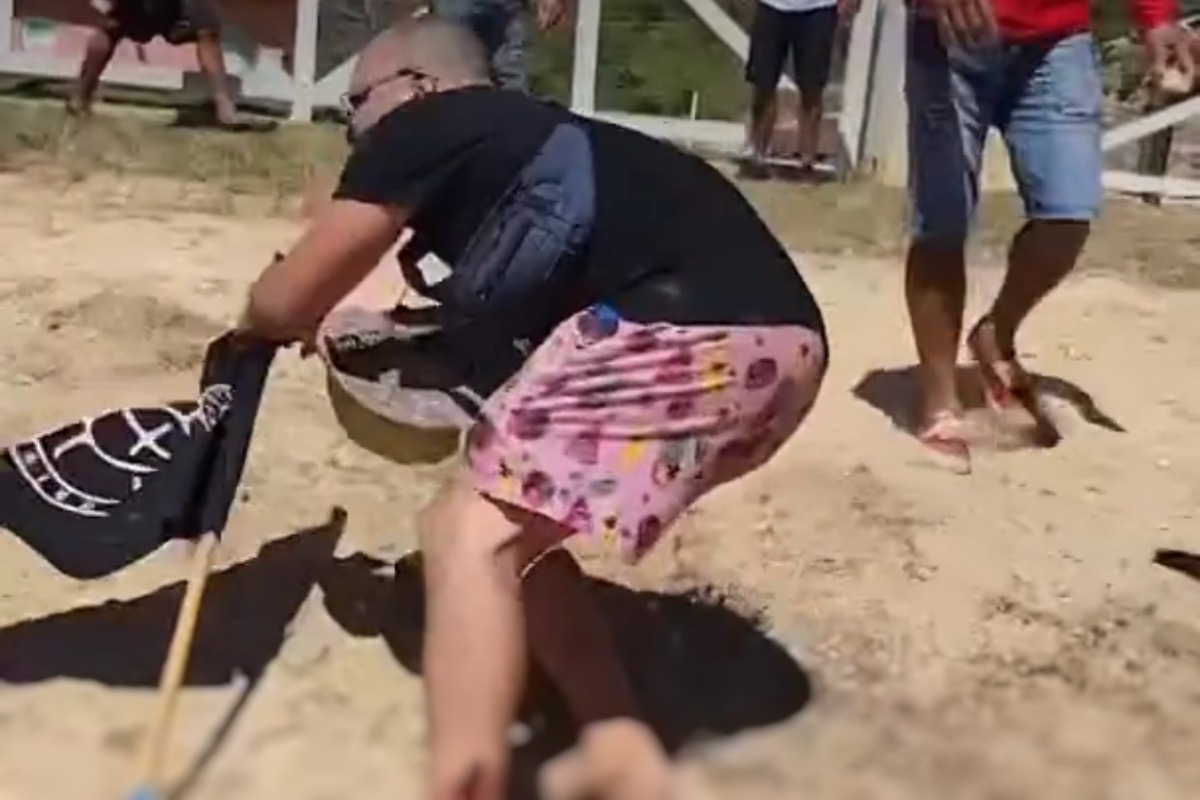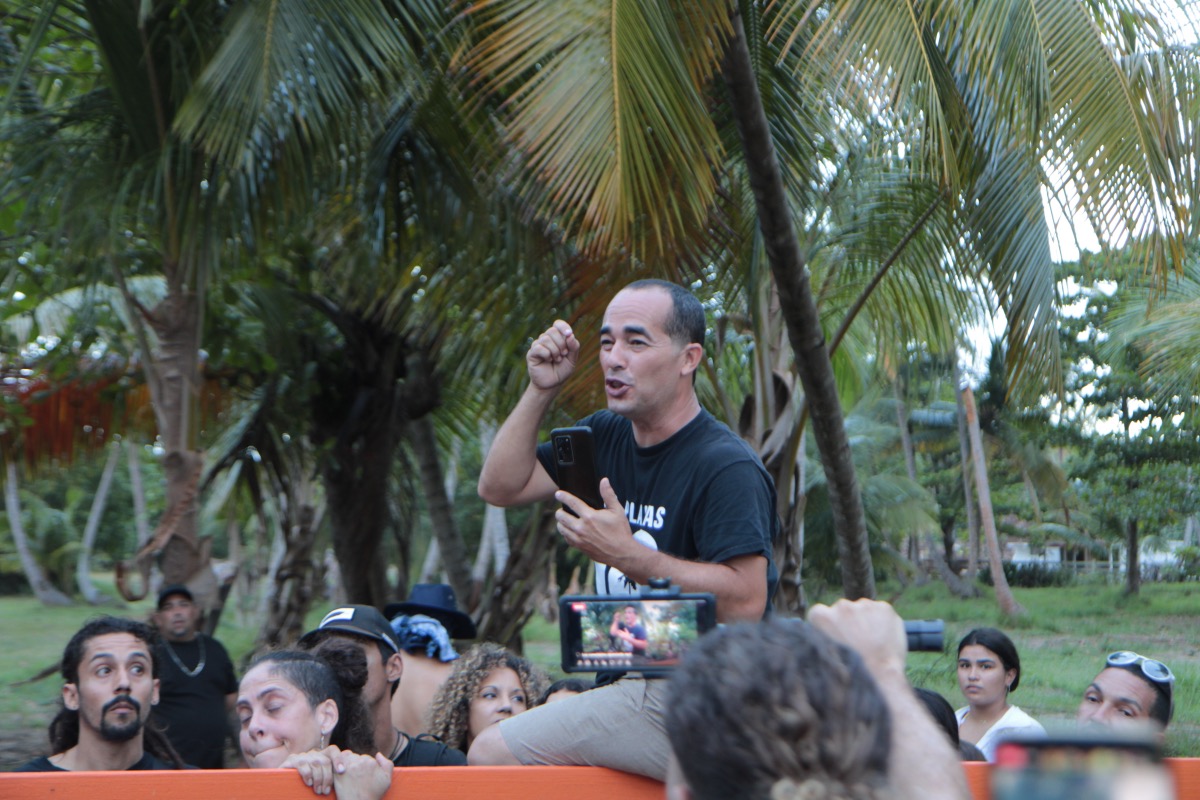

A demonstrator lifts the black Puerto Rican flag of resistance near Cueva del Indio in Arecibo, Puerto Rico, Sunday, October 9, 2022. (Carlos Edill Berríos Polanco/Latino Rebels)
SAN JUAN — Amid sweltering heat, five burly men ripped a cement walkway up from the muddy ground, revealing dead mangrove roots sticking up like grave markers. Activists around them continued tearing down other parts of the path that led into one of more than a hundred wooden cabins built right on the beach, only occasionally stopping to check the progress of the men hacking away at the slab.
When they finished, the crowd cheered and helped them carry the resultant pieces to a huge trash heap next to a cabin owned by the parents-in-law of Puerto Rico’s resident commissioner, Jenniffer González Colón.
“We started with Jenniffer González because my mom taught me we start with the tough dirt!” one activist screamed over the megaphone.
Twice in the past month, activists have gathered in the idyllic La Parguera neighborhood, in the southwest municipality of Lajas, to protest the destruction of mangroves along the coast. The first protest ended with eight activists arrested, many more maced, and one police officer injured. The second protest was much more peaceful, as activists, while still tearing down the construction, planted more than 500 mangrove sprouts in hopes of restoring the destroyed area.


Environment activists tear up pavement leading to a beach home owned by relatives of Resident Commissioner Jenniffer González Colón, Puerto Rico’s non-voting member of Congress. (Carlos Edill Berríos Polanco/Latino Rebels)
Though the protests began solely against González Colón’s family cabin, they quickly extended to the more than 100 other cabins built atop the La Parguera nature reserve over the last half-century—all of which activists are asking to be torn down. Documents dating back decades from both state and federal agencies detail how the reserve was supposed to be cleared of the cabins as they deteriorated and the area restored to its natural state for the “enjoyment of all people.”
But that never happened, and the area has become a hotbed for vacation homes of the rich and powerful.
“We’re here again doing what the departments here aren’t doing—we’re here restoring the area,” environmental activist Ángel Torres Rosado said. He wore a trucker hat reading “People of Puerto Rico Defending the Natural and Environmental Resources,” a parody of the hats worn by the Department of Natural and Environmental Resources (DRNA), the agency charged with enforcing environmental protection laws across the archipelago.
Activists claim the cabins along the coast were rebuilt after Hurricane María struck in 2017, which goes against established guidelines from the DRNA and the permits office.
González Colón has remained quiet on the issue, saying she doesn’t comment on properties that do not belong to her. Her congressional office did not respond to Latino Rebels’ request for comment.
“The owners of the property are elderly adults who have been victims of acts of destruction and vandalism due to the mere fact that their son married a public figure. These have been subjected to an illegitimate attack to advance an agenda of a group of social agitators whose interests are only political and economic,” said Miguel Torres Torres, the lawyer representing González Colón’s in-laws, whose office did not respond to Latino Rebels’ request for comment either.
In early June, a DRNA officer visited the site of González Colón’s family home and found construction had illegally damaged the surrounding mangroves. Torres Rosado detailed how during the first protest he asked a DRNA officer to come with him because police were trampling on mangrove seedlings while they arrested people, but the officer refused, saying, “I can’t go over there.”
DRNA Secretary Anaís Rodríguez Vega has said that active cases in La Parguera “are being managed through legal and administrative procedures.” The DRNA did not respond to Latino Rebels’ request for comment.
“They occupy something knowing that it’s not theirs, but then don’t want people to take it away from them,” said Pedro Cardona Roig, an architect and urban planner better known by his online persona “El Urbanista.”
Scenes like the ones in La Parguera —with activists tearing down illegal construction linked to the powerful, only to be arrested by police while the DRNA looks on— have taken place at nearly half a dozen different beaches across Puerto Rico in recent months.
The two most prominent encounters took place in the northwest municipalities of Rincón and Aguadilla, where activists established “campamentos,” or occupied protest camps, near the illegal construction.
In Rincón, activists have been tearing down construction since 2021. The courts have ruled that the Sol y Playa Condominium had built structures too close to the beach, revoking the property’s construction permits in late 2022. In Aguadilla, activists were eventually successful in forcing the developer, Carlos Román González, to tear down an activities hall and horse paddock built on top of Cueva Las Golondrinas.
But while activists have enjoyed some wins, they have also faced tough challenges along the way, with dozens of environmental activists having been arrested during protests. Activists in Aguadilla have been attacked multiple times by unknown assailants and private security—including an incident where a private security guard shot into a crowd of activists. Torres Rosado himself was shot in the leg during that protest.
Some activists have received death threats for their participation in the protests. Recently, someone set fire to part of Campamento Pelicano in Aguadilla, whose members are still trying to stop the destruction of the karst near Roman González’s company, Aguadilla Pier Corporation.
Activists now fear that state repression has ramped up to a new level. Six of the activists arrested in La Parguera were charged with alleged vandalism, intimidation, threats, and assaulting a police officer, their bail set at more than $500,000. Five of the activists arrested in Aguadilla in early January, after being shot at by private security personnel, will be going to trial for alleged obstruction of justice.
The high bail amount and cause for trial were immediately seen as an attempt to scare activists and make them think twice about continuing their campaigns against environmental destruction. Cardona Roig described the bail amount as “abusive” and said he thought there could be an attempt to repress the protests through the bail and arrests, describing such intimidation a form of “institutional bullying.”
Activists like Cardona Roig are quick to point out that others involved in harsher and more far-reaching crimes received a smaller bail amount when compared to activists in La Parguera. Cesar Toledo Mantilla, the private security guard who shot at activists in Aguadilla, only received $30,000 bail and is facing an attempted murder charge. His trial is still ongoing.


Screenshot from a video showing the moments after environmental activists Ángel Luis Torres Rosado was shot by private security forces while protesting illegal construction in Aguadilla, Puerto Rico, on January 29, 2022.
Walter Pierluisi Isern, former campaign staff member and a cousin of Gov. Pedro Pierluisi, was only given $25,000 after he was charged for his role in stealing over $3.7 million in federal funds. Pierluisi Isern, who owned a condo at Sol y Playa and attempted to interfere with the case, was later sentenced to 43 months in prison.
“What we are witnessing is an attempt to silence the voices that denounce abuses against our natural resources by wealthy individuals and/or a sense of impunity,” said William Ramírez, executive director of the Puerto Rican branch of the American Civil Liberties Union, in a message posted to Facebook. Other lawyers have agreed with Ramírez, calling the bail amount “punitive.”
Threatened, arrested, attacked, and shot, Puerto Rico’s environmental activists have endured a lot while trying to enforce the environmental protection laws they feel the government refuses to enforce. Still, most of them refuse to back down.
“I had withdrawn a little from the fight, and instead of making me walk away, now I want to go back,” Yamize Elias, one of the activists arrested in Aguadilla, told Latino Rebels.
“They are looking for a way to silence us because they know that not only environmental crimes are being brought to light, but so is corruption,” she said.
Repression against climate activists has a long history in Puerto Rico and the rest of the world.
Eliezer Molina Pérez, a prominent eco-activist, has been the target of police repression for the past few years. He was arrested for his role in the Sol y Playa protests in 2021, but was not charged. The Federal Bureau of Investigation investigated threats against Molina’s life as far back as 2021.
This year, Rodriguez Cotto released a voice recording allegedly capturing police officers threatening Molina Pérez’s life. His wife was one of the activists arrested in La Parguera.


Eliezer Molina Pérez, an environmental activist and former gubernatorial candidate, speaks to demonstrators near Cueva del Indio in Arecibo, Puerto Rico, Sunday, October 9, 2022. (Carlos Edill Berríos Polanco/Latino Rebels)
Latino Rebels reached out to Molina Pérez, but he did not respond to our request for comment.
In the late nineties and early aughts, Puerto Ricans forced the U.S. Navy out of the islands of Vieques and Culebra after years of protesting the military presence and its effects on the environment. The governor reinstituted the “Tito Kayak Law,” named after the pseudonym of eco-activist Alberto de Jesús Mercado —best known for protesting in Vieques— which made it a felony to obstruct work at a construction site.
Many view the current environmental protests as merely a continuation of the fights for Vieques and Culebra.
Around the world, climate activism has become a thoroughly dangerous cause to take on. Over 40 activists were arrested and charged with domestic terrorism for protesting a police and fire training facility near Atlanta, known as “Cop City,” which would destroy the South River Forest, one of the city’s four “lungs.”
In the Netherlands, over 1,500 Extinction Rebellion activists were arrested during a protest against Dutch fossil fuel subsidies. Meanwhile, more than 1,700 eco-activists were killed over the last decade while protesting drilling, logging, or mining sites.
***
Carlos Edill Berríos Polanco is the Caribbean correspondent for Latino Rebels, based in San Juan, Puerto Rico. Twitter: @Vaquero2XL



In Brazil and Colombia, environmental activists have been murdered. Will we be seeing similar atrocities in PR, on American soil ?